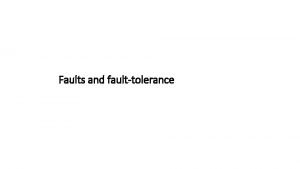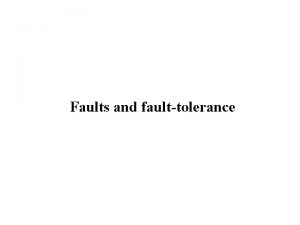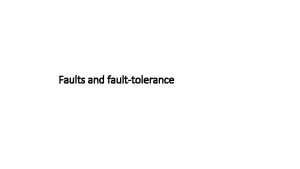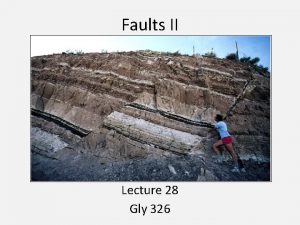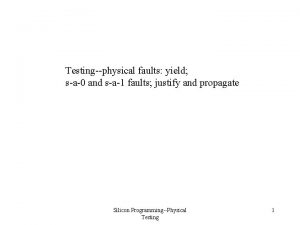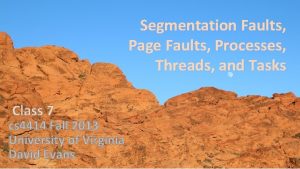Week 2 Faults and waves Day 1 Faults















- Slides: 15

Week 2 Faults and waves

Day 1: Faults • Before: What are faults? • During: Fault notes • After: Exit slip 4 questions

Types of Faults • Fault- a breaks in the earth’s surface along which rocks can move. • Three kinds of faults – determined by how the rocks move against each other: 1. Thrust or reverse fault 2. Normal fault 3. Strike-slip fault

Reverse fault • Reverse fault – rocks push together until a section of rock moves upward

Normal fault • At a normal fault, the rocks on one side try to slip up and over the other set of rocks. • Example: Sierra Nevada Mountains

Strike-slip fault • At a strike slip fault, the rocks on one side of the fault try to slip by the rocks on the other side of the fault. Friction builds up. Then, like a rubber band releasing, the rocks move and there is a release of energy, which we call an earthquake. • Example: San Andreas fault in California.

Day 2 Earthquake Waves

Earthquake Waves • There are three types of waves: 1. P waves 2. S waves 3. Surface Waves.

1. P-waves 1. P waves, or primary waves: – The first waves to reach the surface and also the fastest moving at 4 miles per second. – They push and pull the rock as they move through it, making the initial jolt that people sometimes report feeling.

2. S-waves 1. S waves, or secondary waves, move slower than P waves, at 2 miles per second and move the rock up and down and back and forth. ****P and S waves move through the entire Earth, so they, combined, are also known as body waves.

3. Surface Waves • Surface waves travel only on the surface of the Earth. – They are made by the P and S waves hitting the surface of the Earth. – The make a rolling sensation, sort of like waves in the water. – Often, they cause the most damage, because they can last the longest and they hit areas that have already been weakened by the other

Measuring Earthquakes • There are two scales used to measure earthquakes: the Modified Mercalli Intensity Scale and the Richter Scale.

Modified Mercalli Intensity Scale • Modified Mercalli Intensity Scale – This is less widely reported because it is considered descriptive and relative. It is measured by having survivors of an earthquake fill out a form reporting how the earthquake felt to them.

Richter Scale • The more commonly reported scale is the Richter scale. • The Richter scale is measured using a seismograph to measure the magnitude, or size, of the waves of the earthquake. • The Richter scale is a logarithmic scale, which means that each time you go up one number, the magnitude increases ten time. • The Richter scale has no upper or lower limit.

Measuring Earthquakes • Current seismometers (instruments that record earthquakes) have a recording device, the seismograph, and a record of the earthquake, the seismogram. • Many times they are in remote locations, to be away from the vibrations of shaking of cars, trucks, or airplanes. The data is recorded onto magnetic tapes.
 Day 1 day 2 day 3 day 4
Day 1 day 2 day 3 day 4 Compare and contrast p waves and s waves using venn diagram
Compare and contrast p waves and s waves using venn diagram Day 1 day 2 day 817
Day 1 day 2 day 817 Mechanical waves and electromagnetic waves similarities
Mechanical waves and electromagnetic waves similarities Characteristics of mechanical waves
Characteristics of mechanical waves Differences between mechanical and electromagnetic waves
Differences between mechanical and electromagnetic waves What is a semiconductor used for
What is a semiconductor used for Difference between matter waves and electromagnetic waves
Difference between matter waves and electromagnetic waves Mechanical and electromagnetic waves similarities
Mechanical and electromagnetic waves similarities Seismic waves
Seismic waves Mechanical waves and electromagnetic waves venn diagram
Mechanical waves and electromagnetic waves venn diagram Aimtoknow
Aimtoknow Week by week plans for documenting children's development
Week by week plans for documenting children's development Light is electromagnetic radiation true or false
Light is electromagnetic radiation true or false Characteristics of a longitudinal wave
Characteristics of a longitudinal wave Sound is a longitudinal wave
Sound is a longitudinal wave
























